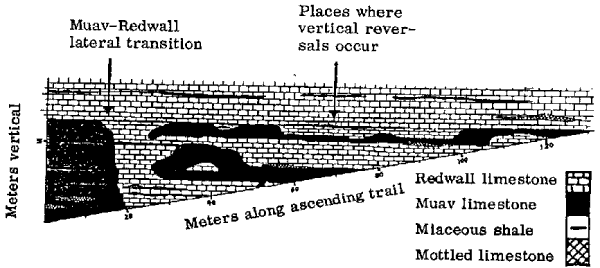 |
Science Frontiers ONLINE No. 51: May-Jun 1987 |
|
|
A QUESTIONABLE 200-MILLION-YEAR HIATUS
Hiking down into the Grand Canyon of the Colorado is a geological education. As one descends past the beautifully exposed horizontal strata, one also turns back the geological clock in welldefined ticks. That is what the signs along the way say, and that is what all the textbooks proclaim! But when the juncture between the Redwall Limestone and Muav Limestone is reached, a 200million-year gap appears. The sign posted here by the National Park Service reads:
An unconformity |
This supposed unconformity is puzling for several reasons:
- The two limestone strata "seem" conformable in most places. Both are nicely horizontal, and there is basically no evidence that 200 million years of erosion and tectonic disturbances separate them.
- In some places, the two limestone strata intertongue or interfinger, such that by moving vertically one flashed back and forth in 200-million-year jumps.
- In both limestone strata, one finds layers of the same micaceous shale containing the same fossil tubeworms, suggesting near-simultaneous deposition.
- In one place, the two limestones clearly grade into one another, with no separation at all.
Anyone who walks down the Canyon trails can see that the evidence for a 200-million-year hiatus between the Mississippian and Cambrian limestones is shaky at best. With the accuracy of geological dating through the use of contained fossils at risk, one would expect many professional papers dealing with this situation. Instead, the geological literature says little. One of the few papers mentioning the "unconformity" states that the contact between the two limestones displays ripples 2 feet from crest to trough, as one might expect with a true unconformity. Such ripples do not seem to exist. (Waisgerber, William, et al; "Mississippian and Cambrian Strata Interbedding: 200 Million Years Hiatus in Question," Creation Research Society Quarterly, 23: 160, 1987.)
Comment. Aha, this paper was written by scientific creationists, who have an obvious ax to grind. There's surely nothing to it. However, the senior author is a consulting geologist, and the paper is replete with photographs and diagrams. And you can always go see for yourself! It is the interpretation of the data that is in question. Where is the error?
Reference. Puzzles in the stratigraphy of Grand Canyon can be found in ESR1 in our catalog: Inner Earth. For details, visit: here.
 | Stratigraphy of the Redwall-Muav contact, North Kaibab Trail, Grand Canyon. Notice the intertonguing. The mottled limestone and the layers of micaceous shale occur in both the Redwall and Muav limestones, even though they are supposedly separated by 200 million years. (Adapted from the CRSQ article referenced in the text). |